Menu
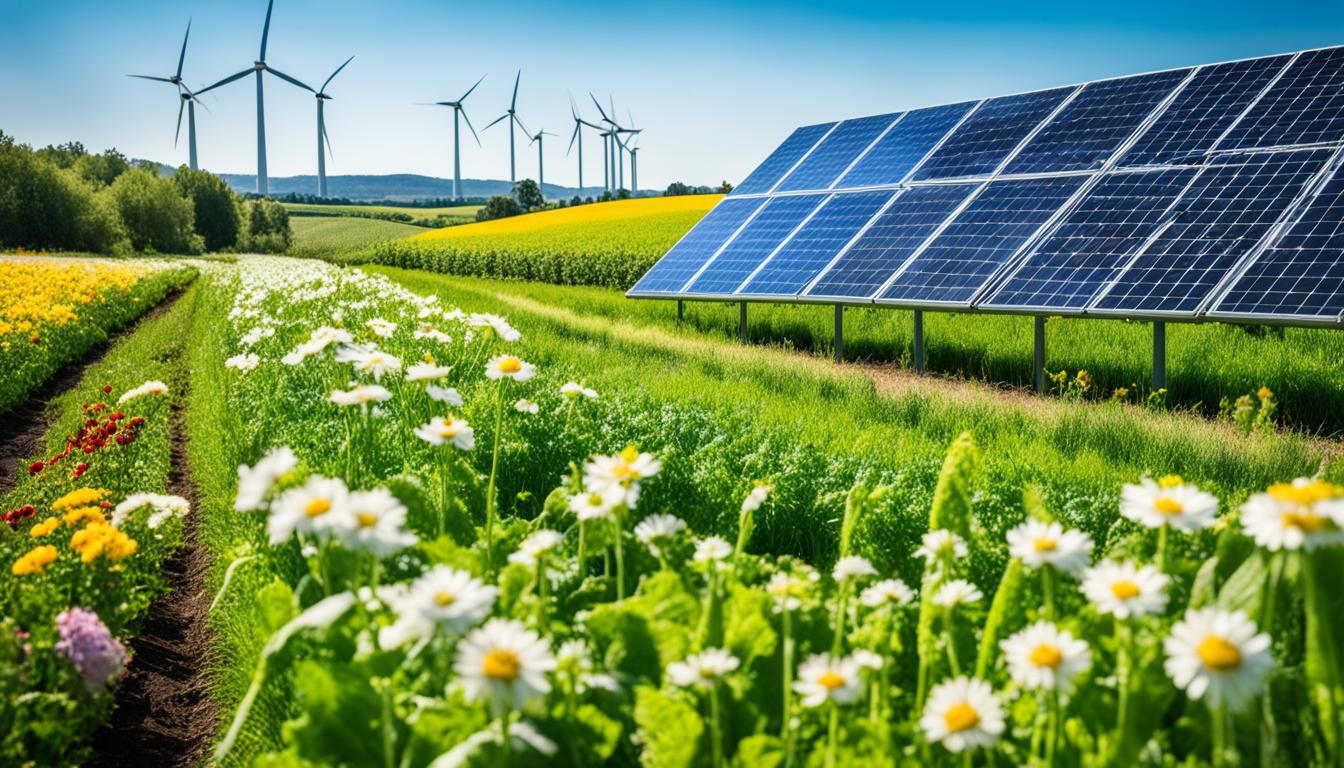
“The soil is the great connector of our lives, the source and destination of all.” — Wendell Berry
Organic Crop Management is at the core of sustainable farming. It uses methods that are kind to the environment. These methods differ from normal farming by reducing the need for things from the outside.
The goal is to keep the soil and life in the farm healthy. This way, by using crop rotation and natural fertilisers, we avoid synthetic chemicals. These methods are crucial for a greener planet.
Organic crop management highlights ecologically friendly farming practices. It avoids synthetic chemicals and focuses on improving soil quality and biodiversity. This method is backed by the USDA and bans the use of certain harmful products.
Organic farming is all about using natural methods to grow crops. It uses techniques like crop rotation and planting different crops together to protect the soil. Methods like compost and manure are used to make the soil healthier.
Plants can help each other grow by being planted near certain types. And, there are friendly bugs that can control pests naturally. Also, using things like straw keeps the soil in good condition by stopping erosion and adding nutrients back to the ground.
Sustainable farming helps keep our water and soil clean by reducing pollution. It also makes the land better for crops in the long run. Things like crop rotation and using natural fertilisers are big parts of this.
Because it doesn’t use toxic chemicals, it’s safer for the environment. It also stops those chemicals from getting into our food. This way of farming also has rules to make sure it stays good for the planet.
Keeping soil healthy is key in organic farming. It influences the quality and sustainability of our crops. To do this right, farmers need to know about soil tests and how to add organic matter to the soil.
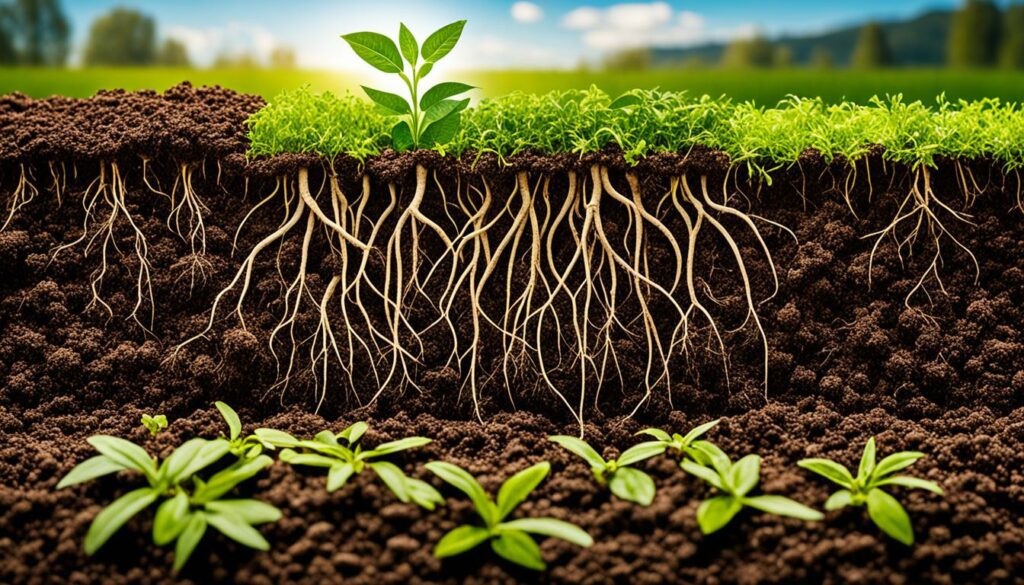
Soil tests are vital in farming. They tell farmers about the soil’s health. This helps in using the right amount of nutrients and planning what plants should be grown next.
The tests show the levels of nutrients like nitrogen, phosphorus, and potassium. They also check the soil’s ability to hold water and its structure. This helps stop problems like soil erosion and runoff.
Taking soil samples helps find out what the soil needs. Experts, called agronomists, help farmers understand these test results. This advice is crucial to apply organic materials properly, without hurting the environment.
Boosting soil’s organic matter is key to a strong organic farm. It’s shown that organic soils in the U.S. keep more carbon. This makes them healthier for farming. Farmers can do this by using cover crops and adding compost or manure.
Cover crops protect the soil and add nutrients back into it. They also help with soil health by increasing the number of important organisms living in the soil. Adding organic matter helps the soil keep more carbon. This is crucial because farming has caused a big loss of soil carbon over the years.
Reducing how much we disturb the soil can be good for tiny soil life. It also helps keep the soil healthy. Keeping the soil covered is important. It saves water, keeps the temperature steady, and stops weeds from growing. This way, it gives a home to other living things in the soil.
For better soil health in organic farms, four things are very important: cover crops, adding organic materials, changing what plants you grow, and how you plough. Having a variety of plants helps keep the soil and its life diverse. This is important for the success of plants and the ecosystem in the soil.
Using the right crop rotation is key in organic farming. It helps keep the soil healthy and boosts the variety of life on the farm. By changing which crops are grown in a set order over about eight years, farmers see big improvements. These include better ways to fight pests and diseases in their plants.
Crop rotation really helps make farm life more diverse. Different plants interact with the soil in special ways, making it richer. This makes the farming system healthier. Crops like legumes and grasses bring important nutrients back to the soil. This reduces the need for man-made fertilizers. It also makes conditions just right for all plants to grow well. The soil becomes strong and can prevent erosion.
Rotating crops is a great way to handle pests and diseases. It messes up the life of these troublemakers, making the farm less friendly to them. For example, changing up crops helped slow down quackgrass in a study in Saskatchewan. Adding perennial forages to the mix also tackles weeds. This is key for fighting off pests and diseases.
This method also makes crops better at handling tough weather and using water well. It shows just how important mixing things up and planning carefully is for healthy food and farms. Diverse and smart farming leads to a better environment for everyone.
In organic farming, cover crops and green manures play a huge role. They help the soil and farm stay healthy in many ways. Even though they might not bring instant profit, their long-term effects are vital. Over the last ten years, more and more studies have shown their value.
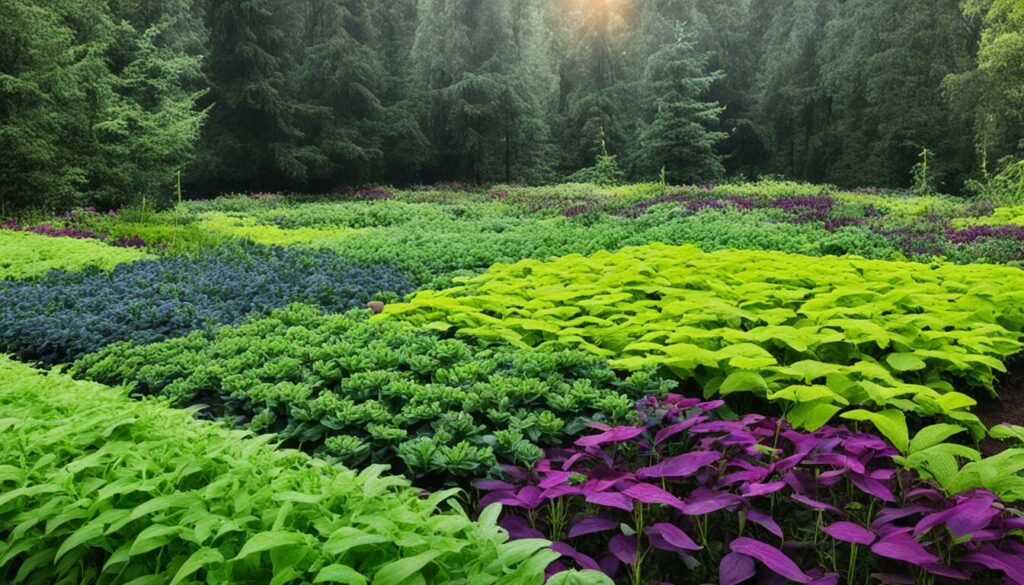
Cover crops have been the focus of a lot of research. For example, 17 studies in The Journal of Soil and Water Conservation back in 1998 looked at them. Such interest proves they’re key in today’s agriculture. Leguminous cover crops can add a good amount of nitrogen to the soil. They can add between 40 to 200 pounds per acre. This helps keep the soil fertile without needing artificial chemicals.
Green manures such as vetch, clover, beans, and peas can make a big difference. They add more organic matter and nutrients to the soil. Take hairy vetch, for example. It can add up to 180 pounds of nitrogen per acre. And about 90 pounds of that nitrogen can be used by the next crops. This extra nitrogen is very important. It’s estimated that 40% to 60% of it directly helps the next crop cycle.
Using such crops can act like a natural carpet. They help stop soil erosion, reduce soil splash, and manage weeds. Adding about 2.2 tons of crop residue per acre each year is important. It helps keep the soil’s organic matter at stable levels, especially when farming a spot over and over again.
| Cover Crop | Benefits |
|---|---|
| Legumes (Peas, Beans, Vetch, Clover) | Nitrogen fixation, soil fertility improvement |
| Grasses (Annual Ryegrass, Oats, Winter Wheat, Winter Rye) | Erosion control, weed suppression |
| Buckwheat | Attractiveness to bees, fast growth |
| Rapeseed | Weed suppression, biofumigation properties |
Using organic fertilisers is important for lasting sustainable fertilisation in farming. They replace harmful chemicals with natural nutrients, helping the soil stay healthy. This, in turn, keeps the land ready for the next planting season.
There are three main types of organic fertilisers. All serve a special purpose for growing plants:
All these fertilisers keep the soil rich in nutrients. They help farming continue without harming the environment. Studies by Bremner & Mulvaney (1982) and Andrews et al. (2002) back these benefits.
Compost in agriculture matters a lot. It adds nutrients, makes soil better, and supports good bacteria. This is key for keeping land productive without harmful chemicals.
Benefits of Animal Manure:
| Fertiliser Type | Key Nutrients | Benefits |
|---|---|---|
| Compost | Balanced NPK | Improves soil structure and provides long-lasting nutrient supply. |
| Animal Manure | High in Nitrogen | Enhances soil’s water holding capacity by adding organic matter. |
| Mineral-based Fertilisers | Slow-release nutrients | Improves how plants take in nutrients over time, reducing waste. |
Animal manure and compost are key for sustainable fertilisation. They help crops grow and keep the farming environment healthy. Barker et al. (2019) and Boafoet al. (2020) have shown their positive impact.
Integrated Pest Management (IPM) is a vital approach to control pests sustainably. It focuses on using less harmful chemicals. Since the 1970s, it has grown, mainly avoiding heavy pesticide use and focusing on preventive steps.
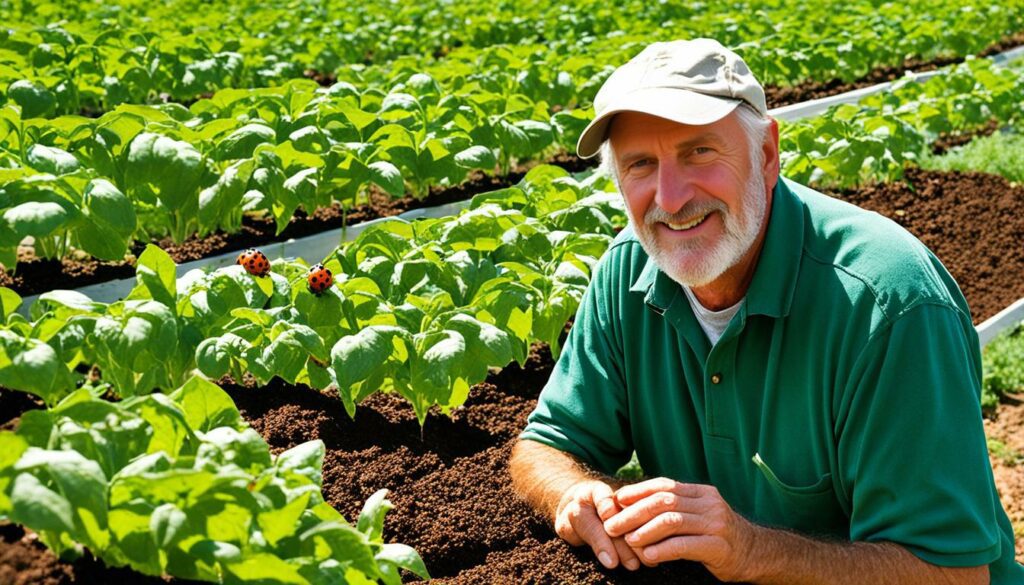
This method protects crops using various tools and methods. It’s all about being proactive to stop pests before they cause trouble. It uses living things and techniques that are not toxic, like rotating crops and keeping the soil healthy.
Certified organic farmers follow strict rules set by the USDA. They must use methods like crop rotations and planting strong plants to fight pests naturally.
One key part of IPM is biological pest control. This means using natural enemies to control pests. It’s safe for the environment and very effective. Letting nature’s balance work helps keep both pests and plants healthy.
Cultural and physical methods are also crucial. These include changing the crops you plant and using plants that resist diseases. Such methods help to make life hard for pests so they don’t grow or survive well.
Covering crops with physical barriers and using traps are quick fixes. They can stop pests without using chemicals.
IPM is key for organic farms to control pests in a natural way. By combining different methods, we can have farms that are healthy and fruitful.
In organic farming, choosing the right organic seeds and plants is essential for a good harvest. Organic farms must use organic seeds whenever they can. But, if the right organic seeds aren’t available, they can use non-organic ones.
Selecting plants that fight off diseases is very important. It helps to lower the risk of losing crops. Using seeds that are either hybrid or open-source can help. Hybrids are known for their large harvests. Open-source varieties add diversity and strength to farms.
Meeting seed certification rules is key to sticking to organic practices. The National Organic Standards Board (NOSB) laid out clear rules on using organic seeds in 2005. Farmers must make an effort to use organic seeds. Also, any treatments on seeds must be organic too.
| Key Requirement | Details |
|---|---|
| Commercial Availability | Ability to obtain seeds in appropriate form, quality, or quantity for organic production. |
| Treated or Non-Treated Seeds | Consideration of seed form, germination rate, and other quality parameters. |
| Verification by Agents | Certifying agents must verify attempts to source organic seeds and review substances used for treatment. |
Good water management is key in organic farming. It saves resources and keeps crops healthy. Organic farmers deal with challenges from water sources both on and off their farms. It’s essential to use smart water-saving methods to keep farming sustainable. These challenges vary by location, local water policies, and the season.
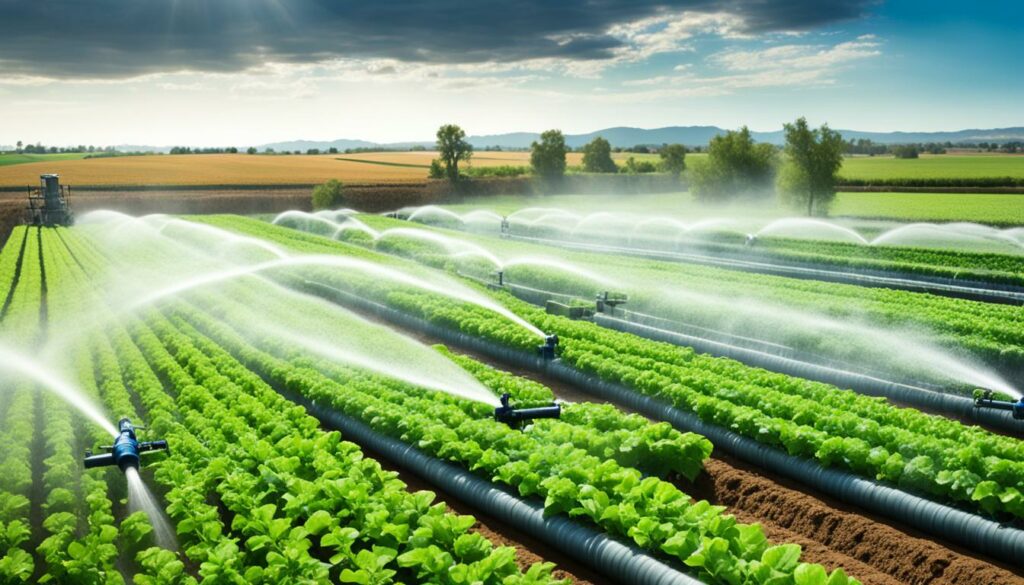
Methods like drip irrigation are essential in saving water on farms. With this, water goes straight to the roots of plants, cutting evaporation. Traditional flood irrigation can lose 10-30% of water. Drip irrigation reduces this to just 2-5%. It’s a great help in organic farming, making efficient irrigation possible.
Using greywater or blackwater recycling is another clever way. This method collects used household water for the farm. It saves clean water and makes farming more self-sufficient. This boosts the sustainability of organic farming.
Smart irrigation systems with AI and sensors are also very helpful. They adjust water use based on the soil’s moisture and plants’ growth. Farming can save a lot of water this way and become more sustainable. These technologies offer a win-win for farmers and the environment.
Advances like robotics, drones, and AI have changed water management in farming. For example, companies like Benchmark Labs use AI to predict the weather. This helps farmers use water more efficiently. Such tech gives farmers key data to manage water and improve their methods. It supports both good farming practices and water conservation.
Efficient irrigation techniques are crucial in organic farming for saving water. They support the overall health of agriculture. With the right tools and methods, farmers can farm in ways that are good for the Earth. Sustainability and eco-friendly farming practices go hand in hand with these approaches.
When talking about top organic tillage methods, we think of two key ones: mulching and conservation tillage. These methods play a big role in keeping soil healthy and managing soil erosion. Let’s look at how they help in organic farming.
Conservation tillage aims to keep at least 30% of crop residue on the soil during high-risk erosion times. This goal supports the National Organic Program’s drive to reduce soil erosion. It also improves the soil’s health in many ways.
Mulching has many benefits. By using natural or man-made materials on the soil, we stop it from drying out, keep weeds down, and prevent the soil from getting too hot. This is a vital part of caring for our soil in an organic way.
Organic farmers in the United States must list their tillage methods in their Organic System Plans, as the USDA requires. This usually involves a mix of hand weeding and using machines to control weeds. Following these rules is key to managing soil erosion well.
The way we till the soil, with which tools, and how deep we go is quite detailed. It’s all about how the tools interact with the soil. Factors like soil type and wetness matter a lot. Using the right equipment and knowing how to use it properly is very important.
Studies have proven that mulching, especially with Green Manure and Mulching Film (GMMF), can boost crop yields and improve the soil. For example, in Tai’an, China, using GMMF raised peanut pod yields by nearly 28% over three seasons. This method also made the soil host more bacteria and improved plant growth.
Organic farmers use a range of tillage tools for different jobs. These tools help with preparing the soil, shaping the land, and managing leftovers from crops. Having the right tools and skills is essential, which is why experts from different fields should work together on this.
Using conservation tillage and mulching offers real savings in money and time. It also helps in working towards a farming future that’s strong and lasting.
| Practice | Benefits | Statistics |
|---|---|---|
| Conservation Tillage | Reduced erosion, improved soil health | 30% crop residue maintenance |
| Mulching | Soil moisture conservation, weed suppression | 27.85% yield increase (GMMF vs RTNM) |
| Hand Weeding & Mechanical Cultivation | Weed control | Required in USDA Organic System Plans |
Keeping organic crops fresh after harvest needs careful storage practices in agriculture. Farmers have to be very careful. They must stop contamination and keep their produce pure.
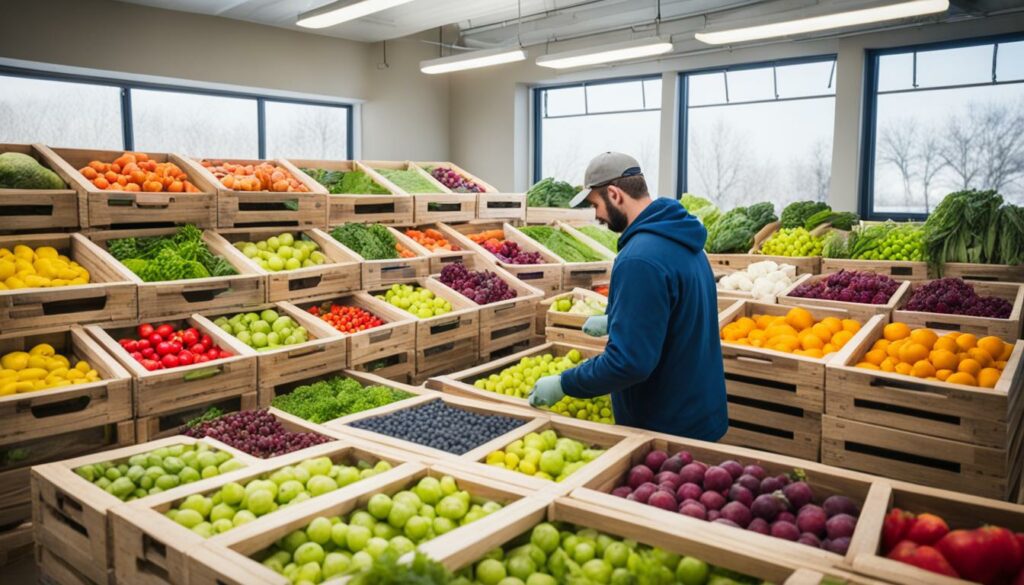
Organic crop storage must stop contamination. Places where crops are stored must keep pests out. They should also keep organic and non-organic products separate. These rules come from the NOP. They ensure organic food is pure at every step.
Good storage techniques keep organic produce fresh. Forced-air cooling is quick and keeps quality high. It can cool crops very fast.
Hydrocooling uses cold water to cool and clean crops. This method is very effective. It keeps the produce fresh and ready to eat.
Vacuum cooling is great for leafy greens like lettuce. It cools by evaporating water in a vacuum. This method is very precise. It helps food last longer.
| Type of Cooling | Speed Efficiency | Best Use |
|---|---|---|
| Forced-Air Cooling | 75-90% faster | Various produce |
| Hydrocooling | Efficient and dual-purpose | General crops |
| Vacuum Cooling | Highly effective for leafy crops | Leafy greens |
GAP is key to safe organic farming. With the right methods and choosing the best plants, farmers can keep their produce safe. This process is vital for good organic food. It makes sure organic food keeps its high quality until it reaches the market.
Buffer zones are key in farming to stop contaminated exposure and boost biodiversity. They act as shields. They protect against pollution from non-organic farms and other sources.
Buffer zones are critical for keeping organic fields safe. They stop banned chemicals from reaching them. The National Organic Program has rules for these zones, usually 25 to 30 feet wide. But, the distance can change based on farm checks and certain situations.
Organic farms must include buffer zones in their plans. These zones can have native plants or ways to stop water runoff. If a farm doesn’t have or look after its buffer zones well, it might not be certified organic. Products from farms with too much banned chemicals can’t be sold as organic.
Buffer zones help more than just preventing pollution. They also make farms richer in plant and animal life. They are great for keeping pests in check and reducing soil erosion by wind and water.
Planting hedgerows and wind barriers stops harmful dust and chemicals. They stop the soil from being washed away. Windbreaks can make more snow collect, adding moisture to the soil. This helps plants grow better and makes watering more efficient.
Buffers along streams and rivers help, too. They catch dirt, plants, and too many nutrients from running off the fields. This protects the land from being washed away. The various buffer zone parts keep the farm pure and support a range of life on the farm.
In organic agriculture, keeping things really clean is key. Agricultural sanitation is vital for stopping diseases. It makes the farm stronger and healthier.
Part of keeping things clean in organic farming is managing leftover crops. Getting rid of old crops helps stop diseases from spreading. It also makes the soil healthier.
Washing farm tools and keeping them sterilised is very important. This stops germs from spreading. A clean farm is a healthy farm, and keeping tools clean is part of the deal.
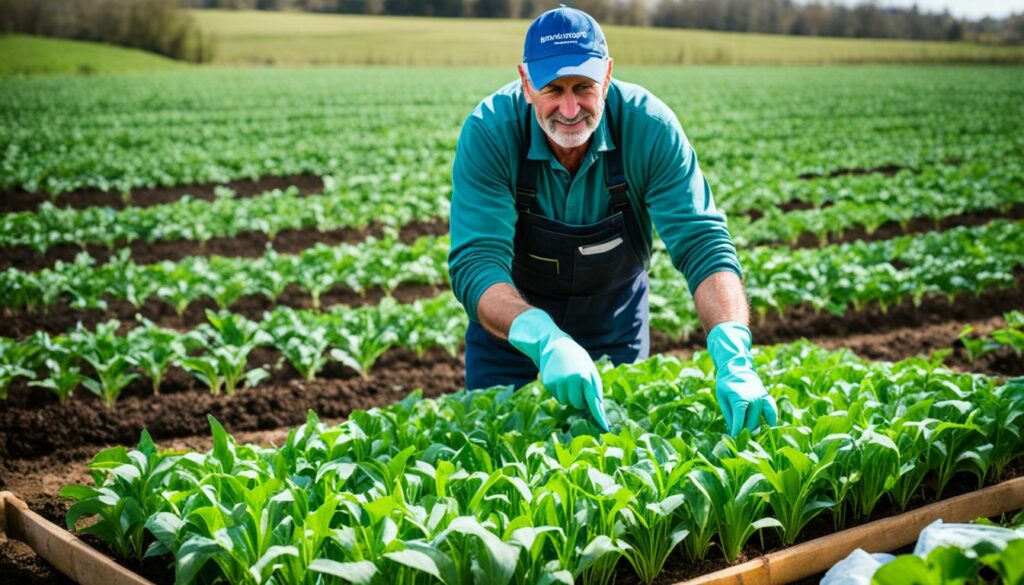
Creating special areas for different tasks can make farms cleaner. It stops germs from moving between places like where the animals are and where crops grow.
Handling old crops well is crucial for a healthy farm. Swapping where different crops grow each year can help break the cycle of pests and diseases. This keeps the farm’s soil rich and full of nutrients.
Overall, using a mix of regular cleaning and disinfecting keeps an organic farm strong. These steps are crucial for keeping the farm productive in the long run.
| Sanitation Measures | Benefits |
|---|---|
| Crop Residue Management | Disease control and soil health improvement |
| Cleaning Equipment | Reduces contamination risks |
| Controlled Access Zones | Minimises cross-contamination |
| Sanitising and Disinfecting | Improves overall farm hygiene |
The organic food market is growing fast, making the economic case for sustainable farming more important. For farmers and those involved, looking at the costs and benefits of going organic is key. This includes seeing what people want in terms of organic products.
Starting with sustainable farming might cost more at first. Even though some farmers do make more money, 60% of them find the high costs a big problem. Investing in things like drip irrigation and rainwater harvesting is smart since it saves water. But, farmers need to think about how much this will cost over time.
The demand for organic products keeps getting higher. Now, 85% of people are okay with paying extra for organic food. This shows that turning to organic farming can actually pay off. In 2017, the global organic food market was worth $97 billion. This was a 9% increase from the year before, showing that more and more people are choosing eco-friendly options.
Bringing together organic standards and sustainable practices is vital for balanced farming. Organic standards mean no synthetic chemicals. Sustainable agriculture protects natural resources for the future. Both work together for stronger farming.
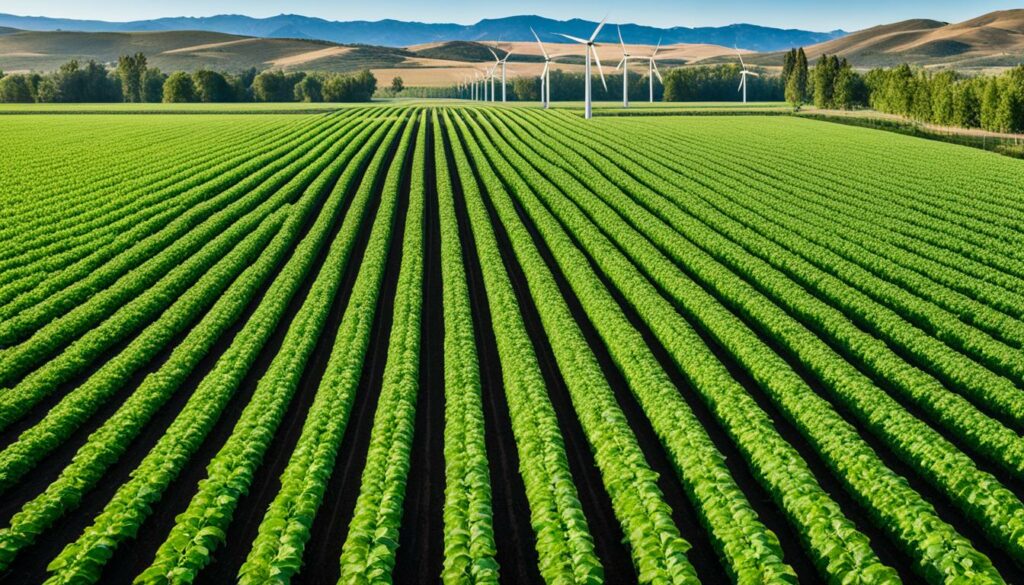
It’s tough but crucial to mix sustainability with organic rules. Organic farming cuts out genetic engineering and synthetic chemicals. It insists on crop rotation for healthy soil. Sustainable organic farming aims to be good for the environment and economy. This balance keeps the land fruitful without hurting it. It lets us keep getting good things from the earth.
Around the world, farms are blending organic and sustainable methods well. In the U.S., family farms are a great example. They get their ingredients from similar farms. This helps in eco-friendly and profitable farming. These farms make their soil richer by rotating crops. They avoid chemical pesticides. Livestock are raised without added hormones, following organic rules. This also helps in sustainable farming. Such farm management has increased productivity while being good for the environment.
To sum up, moving towards sustainable organic farming means combining these practices. This not only meets organic standards but also ensures long-lasting sustainability. Together, they create a stronger farming future.
India’s rich landscape showcases amazing organic farming case studies. These highlight sustainable farming across many areas. Despite just 2% land in organic use, these stories show India’s big step towards green farming.
Madhya Pradesh leads in India’s organic farming, covering 40% of it. It has over 100,000 organic farmers. This makes it a key model for others to follow.
Rajasthan is also working hard, with 60,000 hectares in organic farming and almost all its farmers willing to switch.
Maharashtra shows a big green farming model across 84 villages. It involves 4 million farmers and is a grand example.
Sikkim is special, becoming the world’s first fully certified organic state. Its success has benefited many farming families and greatly increased tourism.
In North-Eastern India, Meghalaya’s ‘Mission Organic’ is significant. It aims to make 2 lakh hectares organic for a sustainable future. Assam is joining in, showing a rising interest in organic farming.
“Nepal’s organic farming progress is clear in districts like Kathmandu and others. The growth shows the importance of better farming conditions.”
Worldwide, many organic farms are leading the way in sustainable food. These farms not only secure food but also keep farmers healthy. They save costs too, sometimes selling at much higher prices abroad.
In India, organic farming has grown a lot. There are now 3.56 million hectares of certified organic land. These produce 1.70 million tons of certified products.
Madhya Pradesh, Maharashtra, and a few other states are the top producers. The US, European Union, and others buy a lot of this organic food.
| State | Organic Area (ha) | Organic Farmers |
|---|---|---|
| Madhya Pradesh | 40% | 100,000+ |
| Rajasthan | 60,000 | 97.3% adoption |
| Maharashtra | 8-10 lakh | 4 million (MOFF) |
| Sikkim | 76,000+ | 66,000 families |
These cases are gold for new farmers worldwide. They prove that green ways are the future and are full of good results.
The future of organic farming is at a key point. It’s driven by big changes in agriculture and the push for sustainable farming. In the US, the amount of organic-certified land has more than doubled since 2000. It went from 1.8 million acres to 4.89 million acres by 2021. This shows the strong interest in eco-friendly farming and the need for organic food.
Important developments are changing how we manage organic crops. One key trend is the increase in government support for organic research, thanks to the USDA. They’ve boosted their funding, taking it from $3 million in 2002 to $50 million in 2023. This big investment in new farming techniques shows how important organic farming is becoming.
Also, sales of organic fruits and vegetables are booming. They topped $22 billion in 2022, making up about 36% of all organic sales. This rise is mainly because people want healthier and planet-friendly food. Big supermarkets, which sold 55.6% of organic products in 2021, are now key places to buy them. This shift is making organic food more available to everyone.
But, there are still tough issues for organic farming to overcome. For example, even though organic land is less than 1% of all US farmland, organic sales make up about 3% of farmers’ income. This gap highlights the challenges organic farmers still face.
Climate change is another pressing issue. It’s hitting small farmers hard, especially those in the mountains. They’re dealing with unpredictable rain, droughts, and rising temperatures. This makes farming harder and some farmers are tempted to use harmful chemicals again.
Yet, there is hope. New, eco-friendly farming solutions like Jholmal, Jeebamrut, and vermicompost are helping. They keep the soil healthy and boost crop yields. These solutions show that organic farming can tackle climate challenges in a safe way.
In the face of big challenges, there are also great opportunities. The idea of creating Resilient Mountain Villages that support organic farming is one example. These places focus on farming in a sustainable way, which helps meet global sustainable goals. It’s all about making farming do well despite the climate challenges and protecting the environment.
As we steer the future of organic farming, it’s key to balance growth with challenges and chances. This smart way forward will set us up well for the next chapter in managing organic crops.
We’ve covered a lot about organic crop management and its important points in farming. We talked about strategies and organic management insights key for good farming. These ideas are crucial for growing crops organically.
First off, keeping the soil healthy is top priority. In Georgia, most farm soils don’t have much organic matter. We should aim to increase soil organic matter to at least 3% for best results.
It’s also key to use only certified organic seeds or seedlings. Banning GMO seeds shows our dedication to core practices in organic cultivation. For fertilisers, we choose those from animals, plants, or minerals. This means no synthetic fertilisers like ammonium sulfate.
Dealing with pests, weeds, and diseases in organic farming means using natural solutions. Things like neem oil for pests and Bacillus thuringiensis for bugs are common. Plus, having buffer zones at least 25 feet wide helps stop contamination from others’ lands.
Another important rule is from the NOP Handbook. It says organic crops must stay separate from non-organic ones during handling and storage. This helps keep organic products truly organic.
The U.S. has seen a big push in organic agriculture, starting in 1940 thanks to J.I. Rodale. His efforts and the work of Albert Howard have shaped organic farming. Their ideas are still a big part of the farming we do today.
Studies show organic farming is good for the earth in many ways. It means less soil erosion, lower use of fossil fuels, and less harm from pesticides. Even though there was a rough patch in the 1960s, organic farming is now stronger than ever.
The basics of sustainable farming are rooted in preserving soil, using organic materials well, and protecting the environment. These organic management insights keep organic farming at the forefront of eco-friendly agriculture.
Organic crop management is key in the world of sustainable farming. We’ve looked at how it helps the environment while boosting crop growth. Keeping the soil moist and weed-free before planting is important. So is avoiding heavy ploughing. These methods make the soil healthier and crops better in the long run.
Modern irrigation methods in organic farming are a big step forward. They include micro-sprinklers and low-sprinklers which save a lot of water. Using these saves about 90% water, compared to old flood methods. The way we store crops after they’re harvested is also crucial. The right moisture levels keep food from spoiling. Cereals should be at 14.5% moisture to stay good. Alfalfa bales need 18-20% moisture to be high quality.
Organic farming boosts and cares for nature. It does this by planting different crops to help the soil, using plants that gather nitrogen, and planting ground cover. These methods improve the soil and help the environment. Also, adding special plants to animal pastures makes the land more diverse and productive.
For the future, organic farming looks very promising. By using a variety of crops and taking care of the soil, it can do even more for the planet. The use of organic fertilisers and ways to reduce ploughing are also important. These measures show how organic farming can make our future greener and stronger.
Organic Crop Management (OCM) is a way of farming that cares for the earth. It focuses on using natural ways to grow crops. This approach helps the soil stay healthy and supports a variety of plant and animal life.
Organic farming helps the land and resources last long. It improves the soil, helps more plants and animals live there, and saves water and soil. By avoiding harmful chemicals and using natural methods, organic farming keeps the environment healthy for the future.
Testing the soil is key in organic farming. It tells farmers what the soil needs to improve. This way, they can use natural methods to make the soil better for growing plants. Good soil is essential for organic farming success.
Adding organic material to the soil makes it better for plants. It keeps the soil structure strong, helps plants get their nutrients, and holds water. By using less intrusive farming methods and adding composts, organic farmers ensure their soil thrives.
Rotating crops helps keep the farm lively and balanced. It stops one type of plant pest from spreading too much. It also makes the soil more fertile over time. This way, the farm supports a wide range of plants and animals.
Cover crops and green manures are special plants that help the main crops grow better. They shield the soil, boost nutrients, and encourage helpful tiny organisms. These practices keep the soil rich without using harmful chemicals.
Organic farms use fertilisers that are natural and not harmful. This can be from animals, plants, or minerals. These fertilisers give plants the nutrients they need, making farming sustainable and healthy.
IPM in organic farming uses nature to manage pests. It involves good farming practices and using friendly bugs or plants to control bad pests. This way, farmers keep their crops safe without using chemicals.
Choosing the right seeds is important in organic farming. They should be strong and not easily sick. Making sure they are certified organic keeps the farm in line with natural farming methods.
Using drip irrigation is smart for organic farms. It saves water and gets it right to the plants’ roots. This method keeps the plants healthy without wasting resources.
By covering the soil and not tilling it too much, farmers protect it. Mulching and being careful with the soil’s top layer saves water and keeps it rich. This is good for the plants and the environment.
Organic crops must stay away from non-organic ones to avoid contamination. Storing them correctly and keeping pests away by natural means is essential. This ensures the organic harvest stays pure.
Buffer zones protect organic farms from harmful chemicals coming from nearby non-organic farms. They also help more plants and animals live around the farm. This is good for everyone and the environment.
Cleanliness on the farm makes it healthier for the crops and the people working there. Getting rid of old plant parts and keeping everything clean fights sickness. This is key for a successful organic farm.
Being a sustainable farmer means using methods that don’t harm nature while still making money. With more people wanting healthy organic food, sustainable farming is a good business. But, farmers need to make sure their methods are also good for their wallet.
Making a farm both organic and sustainable means balancing best practices. These practices should be good for the land, the society, and the business. This creates a farm that is truly in harmony with nature.
Through real examples, we see how sustainable farming works and succeeds. These studies inspire others to follow, showing what’s possible with care for the earth. They teach farmers new ways to grow food that is good for everyone.
The future of organic farming includes new ideas and ways to do better. Farming will adapt to new challenges and find new ways to protect the earth. It’s important to keep improving in order to farm sustainably.
Key points in organic farming are respect for the environment, keeping the soil and plants healthy, and thinking about farming as a whole system. Combining the right practices leads to success that is good for the land and the people.